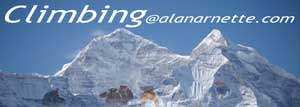One measure of climbing difficulty is the rating and climbing has a terminology of it’s own. You read that she just redpointed a 5.12c and wonder if this was something from NASA, or Congress.
I have seen Everest described as a simple “walk-up” meaning that no actual climbing is involved so I thought a quick review of what defines climbing might be helpful. I will use the South Col route as the example.
One point to keep in mind that the base definition of “technical” often means that climbers must use crampons and an ice axe. This implies skills with snow travel, ed crevasse rescue and self-arrest techniques – all of which are needed for a safe Everest climb from base camp to the summit; and back.
There are many ways of grading climbs but I used the Yosemite Decimal System (YDS) since many people are familiar with it. However using the Alpine Grade might be more beneficial. I will discuss this at the end.
A final preamble item, one word: altitude. This makes all the difference and more complicated with snow and ice. Walking on flat ground at 20,000′ is vastly different than walking on flat ground at sea level – obviously. Please keep this in mind as you read these descriptions relative to Everest.
Class 1:
[singlepic id=1 w=160 h=120 float=right]
Trail hiking. Mostly groomed trails that are easy to find in the summer and relatively smooth. You walk upright without using your hands for balance. It can be a little steep at times.
The trek to Everest Base Camp is mostly class 1 intermixed with brief class 2 sections.
Class 2:
[singlepic id=2 w=160 h=120 float=right]
Simple off-trail hiking. Some scrambling may be required on the route with an occasional use of the hands for balance. Down climbing is straightforward.
Kala Patar at 18,192′ (remember altitude) would be a class 2 route with some scrambling required near the summit using hands for balance.
Class 3:
[singlepic id=3 w=160 h=120 float=right]
This is actual “climbing” since you frequently scramble using your hands. Handholds are easy to find. You can down climb facing out from the route.
This picture show climbers at the top of the Geneva Spur at 26,200′ using the fixed rope. Some of the route from Camp 2 at the base of the Lhotse Face to the South Summit is class 3 but mostly class 2 via the fixed ropes.
Class 4:
[singlepic id=4 w=160 h=120 float=right]
Simple climbing, with exposure. You must look for handholds and test them that they will hold you before using. You use your upper body muscles. A rope is often used for down climbing (rappelling). Falls may result in serious injury or even death.
Climbing a ladder is considered class 4. Some climbers feel that class 4 is really entry class 5. Confused yet?
I would rate the Khumbu Icefall overall as class 4 due to the crevasse danger and the need to use hands and feet on ladders and climbing over ice formations. However, a large part of the Icefall is on somewhat smooth terrain which would be rated class 2, however at 19,000′. Remember the most difficult section drives the overall rating.
Sections of the Lhotse Face and Cornice Traverse would be class 4 due to the exposure. The Hillary Step is class 4 at 28,740′.
Class 5:
[singlepic id=5 w=160 h=120 float=right]
True technical climbing normally using ropes, carabiners, anchors (protection), harness, etc. Climbers often belay one another. In the winter you use an ice axe and crampons. There are sub-ratings for class 5 ranging from 5.0 for “easy” climbs with frequent hand and foot holds to 5.13 that has smooth surfaces, narrow cracks and vertical rock on an overhang.
With the route fixed, almost none of the South Col route meets these definitions even though an axe and crampons are used. However, obviously, there are much more difficult routes on Everest that significantly exceed the South Col and Northeast Ridge difficulty.
All of this discussion uses the Yosemite Decimal System which was designed primarily for rock climbing. There are other systems for alpine climbing, ice climbing and alternative rating systems from the European rating system and the Alaskan rating system. See this link for more information.
So no matter how you rate Everest, it is a lot of fun and test all a climber’s skills. This video shows me rappelling in the Khumbu Icefall.
Climb On!
Alan



6 thoughts on “How Difficult is Climbing Everest?”
Great review Alan. I wonder if the person who described Everest as a ‘simple walk-up’ has actually climbed on Everest!
Mount Everest The British Story
Climbing News
Loved this article. I’m planning on doing the Base Camp Trek in 2012 and as always I value your opinion as to what to expect. I was also thrilled this week to notice on your digital photography section, you rate the Nikon D5000 very high for trekkers. I bought one 2 weeks ago without knowing your opinion!! Needless to say I was glad to see your opinion of it. Thanks for your coverage, I follow it every day on my iPhone.
Thanks Ginger. EBC in 2012 sounds exciting. I like the big SLRs for trekking due to better lens and thus image quality. Here’s to a fun season covering Everest!
Nice post Alan, thanks. In my opinion I would say that Everest (South Col Route) is not technically difficult, but it is dangerous..altitude as you say and objective dangers like the icefall. People often get a wrong perception of Everest and quote ” a blind man has climbed it”, “man with no legs”, ” 76 year old” etc, but often forget that World Class mountaineers have unfortunately not returned from this route.
Nice post. Can’t see the video, it is “private”
Thanks Antoine, It is now ready for viewing.
Comments are closed.